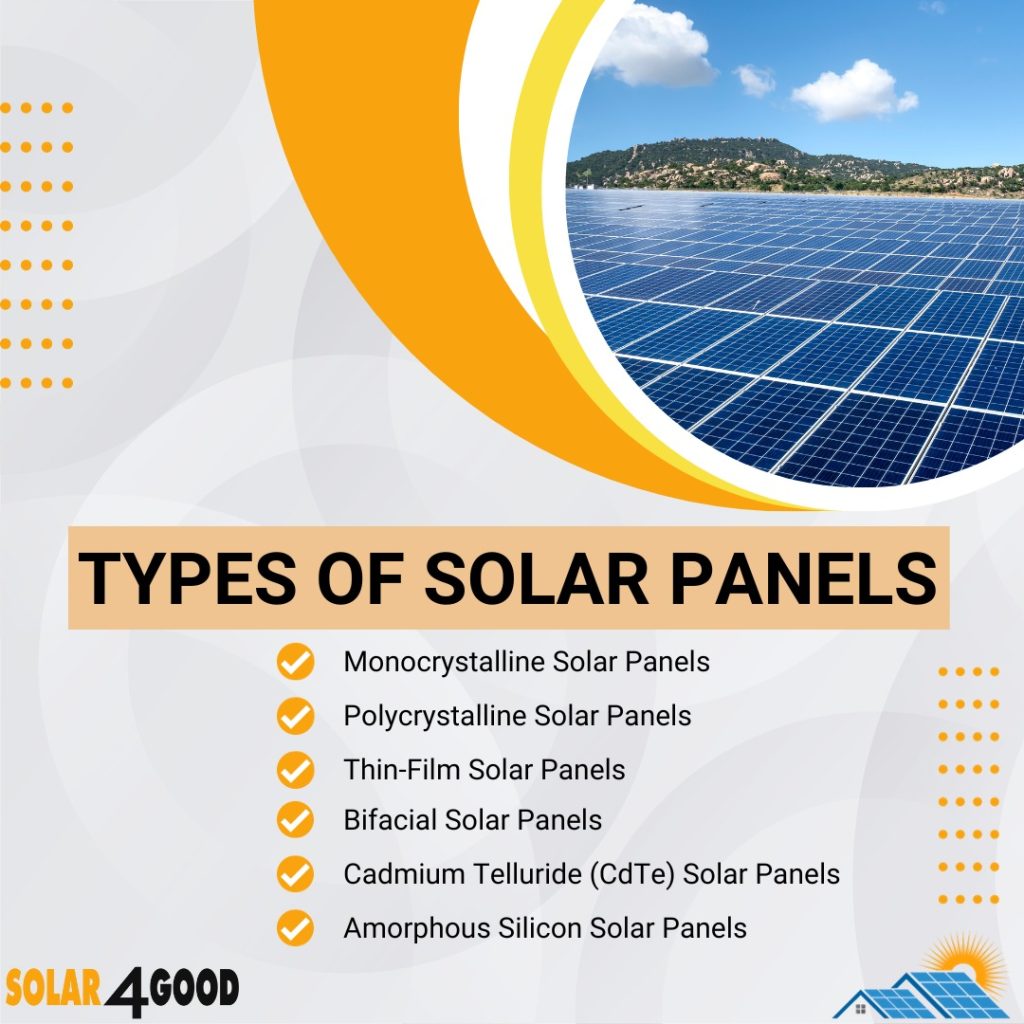6 Types of Solar Panels : Which One is Best For You?
Solar panels come in various types, each with its unique characteristics and applications. Understanding these types can help you make informed decisions when choosing the right solar panel technology for your specific needs. In this guide, we will explore six distinct types of solar panels.
1. Monocrystalline Solar Panels
Monocrystalline panels are made from single-crystal silicon, resulting in a highly efficient and space-saving design. They are easily recognizable by their dark appearance.
Advantages of Monocrystalline Panels
High Efficiency: Monocrystalline panels offer the highest efficiency among all types, making them ideal for limited roof space.
Space-Efficient: Their compact design allows more panels in smaller areas.
Aesthetic Appeal: The sleek black or dark blue appearance is visually appealing.
Disadvantages of Monocrystalline Panels
Higher Cost: Monocrystalline panels are typically more expensive due to their efficiency and manufacturing process.
Applications of Monocrystalline Panels
These panels are suitable for residential, commercial, and industrial applications, especially when space is limited.

2. Polycrystalline Solar Panels
Polycrystalline panels are made from multiple silicon fragments, resulting in a cost-effective design. They are recognizable by their blue-speckled appearance.
Pros of Polycrystalline Panels
Cost-Effective: Polycrystalline panels are more budget-friendly compared to monocrystalline panels.
Reliable Performance: They offer a balance between efficiency and affordability.
Cons of Polycrystalline Panels
Slightly Less Efficient: Polycrystalline panels are less efficient than monocrystalline panels.
Common Uses of Polycrystalline Panels
Polycrystalline panels are often used in residential installations where cost savings are a priority.
3. Thin-Film Solar Panels
Thin-film panels use a variety of materials like amorphous silicon, cadmium telluride, or copper indium gallium selenide. They are lightweight and flexible.
Benefits of Thin-Film Panels
Flexibility: Thin-film panels are adaptable and can be integrated into various applications.
Lightweight: They are suitable for portable and off-grid solutions.
Drawbacks of Thin-Film Panels
Lower Efficiency: Thin-film panels are less efficient compared to crystalline panels.
Areas Suitable for Thin-Film Panels
Thin-film panels are used in niche applications such as solar shingles, portable solar chargers, and flexible solar panels.
4. Bifacial Solar Panels
Bifacial panels can capture sunlight from both sides, increasing energy production. They can be monocrystalline or polycrystalline.
Advantages of Bifacial Panels
Enhanced Efficiency: Bifacial panels capture reflected sunlight, increasing energy yield.
Versatility: They can be used in various environments.
Limitations of Bifacial Panels
Cost: Bifacial panels tend to be more expensive due to their enhanced design.
Ideal Scenarios for Bifacial Panels
Bifacial panels are suitable for commercial and utility-scale installations, particularly in settings with reflective surfaces like snow or water.
5. Cadmium Telluride (CdTe) Solar Panels
CdTe panels use cadmium telluride as the semiconductor material, making them lightweight and cost-effective.
Advantages of CdTe Panels
Cost-Efficiency: CdTe panels are economical to manufacture.
Low Carbon Footprint: They have a lower carbon footprint during production.
Disadvantages of CdTe Panels
Lower Efficiency: CdTe panels are less efficient than crystalline panels.
Usage of CdTe Panels
CdTe panels are often used in large-scale utility installations and projects where cost-effectiveness is a priority.
6. Amorphous Silicon Solar Panels
Amorphous silicon panels use non-crystalline silicon and can be deposited on various substrates, providing flexibility.
Pros of Amorphous Silicon Panels
Versatility: Amorphous silicon panels can be integrated into various applications.
Tolerance to Shade: They perform well under partial shading.
Cons of Amorphous Silicon Panels
Lower Efficiency: Amorphous silicon panels have lower efficiency compared to crystalline panels.
Practical Applications for Amorphous Silicon Panels
These panels are suitable for applications like solar calculators, consumer electronics, and solar-powered watches.
Understanding the different types of solar panels and their unique attributes can help you make informed choices when considering solar energy for your home, business, or special projects. Depending on your priorities, whether it’s efficiency, cost-effectiveness, or flexibility, there’s a solar panel type that’s perfect for your specific needs.
You Are Just One Step Away From A Lifetime Of Savings
Fill Out The Form For Free Consultation
Or Call Us At 0800 999 1454

Head Office
- 79 College Road, Harrow, England, HA1 1BD
Leicester Office
- 1 Meridian South, Leicester, LE19 1WY
Basildon Office
- 3 Buckwins Square, Basildon, SS13 1BJ, United Kingdom.
Glasgow Office
- Simple Business Centre, 14 Carmyle Avenue, Glasgow G32 8HJ
Exeter office
- Queensgate House, 48 Queens Street, Exeter EX4 4SR.
Manchester office
- First Floor, Swan Buildings, 20 Swan St, Greater, Manchester M4 5JW.
- Registered in England and Wales, Company No: - 13101514
SERVICES
©2023 This website is the property of Solar4Good UK Ltd. The content of this website and the information contained therein informs the user of the services provided by Solar4Good UK.





